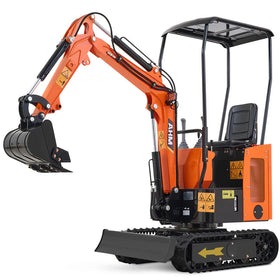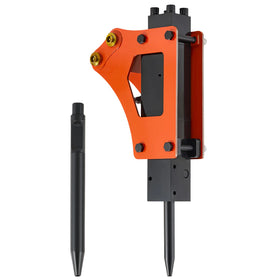When drainage systems are inadequate, pooling water can create significant damage that leads to heightened risk of structural problems, particularly in clay soil regions.
Industry data shows that standing water on your property is almost always the result of improper drainage, and while these problems are fairly easily remedied, they require the right approach and equipment.
A mini excavator changes the equation completely. With precise control and enough power to dig at the right depth, you'll create solutions that last decades instead of seasons.

Three Drainage Solutions With a Mini Excavator
When water pushes against foundation walls, they can crack and bow inward. Experts call this "hydrostatic pressure." It's the main cause of expensive foundation repairs.
Here are three proven solutions you can build with a mini excavator:
1. French Drains That Keep Working Year After Year
Most French drains fail within 5 years. Why? Because they use cheap black corrugated pipes that clog, crush, and leak.
These cheap pipes attract roots at their many connection points. They collapse under soil weight. They fill with silt because they're not installed properly.
A proper French drain needs three things:
- Depth of at least 22 inches
- Steady downhill slope (1.5-2% is ideal)
- Clean gravel separated from soil
With a mini excavator, you can create straight trench walls that won't collapse. You can maintain the same depth across the entire path. You can place gravel without mixing it with soil.

The result? A drainage system that keeps working for 20+ years instead of failing after the next big rain.
Further Reading: French Drain Installation With a Mini Excavator
2. Swales That Add Household Value While Moving Water
Water that can't drain creates soggy soil. This kills plant roots and packs the soil down hard. Plants can't get nutrients or water when this happens.
Mini excavators offer wide grading buckets (36-48 inches). These create gentle swales that blend into your landscape. They move thousands of gallons during heavy rains. Yet they look like a planned part of your yard, not an ugly ditch.
3. Dry Creek Beds That Solve Multiple Drainage Problems
About 25% of all home insurance claims involve water damage. It's the second most common claim type after wind damage.
A dry creek bed solves multiple problems at once:
- It moves water away from structures
- It creates an attractive landscape feature
- It eliminates mosquito breeding areas
- It can increase your property value
With a mini excavator, you can:
- Shape natural-looking channels with varying widths and depths
- Create planting areas for water-loving plants
- Place heavy decorative stones precisely
I transformed a muddy side yard that flooded with every rain into a beautiful creek bed. The project took one weekend with a mini excavator. Now it's the most commented-on feature of the property.
Why Mini Excavators Are Perfect For Drainage Work
Studies show one in every 60 homes files a water damage claim each year. These claims average nearly $14,000 each.
Most people rent big equipment or use shovels. Both lead to problems.
Big equipment can't fit between houses or near foundations. That's where most drainage problems happen.
Shovels can't dig deep enough. They can't create the exact slopes water needs to flow properly.

Let me explain why mini excavators excel at this task from an engineering perspective.
They Fit Where Water Problems Start
Water collects in the tight spaces between buildings. Full-sized equipment can't reach these spots.
Standard mini excavators are just 3 to 5 feet wide. They can squeeze between homes, around trees, and into backyard corners.
The newest zero-tail swing excavators can rotate completely within their own footprint. This lets you work in spaces as narrow as 4 feet so you won't damage nearby structures or plants.
They Create Perfect Water Flow Paths
Water needs a steady downhill path. Experts recommend a slope of 1 inch per foot for the first 5-10 feet from your home.
Try creating that exact slope with shovels. It's nearly impossible.
A mini excavator's bucket and arm system works like a precise measuring tool. You can set and maintain exact depths across long distances.
This precision matters. Even a half-inch dip in your drainage path creates a spot where water pools. That's where systems fail.
They Dig Deep Enough to Last

Most drainage problems come from shallow trenches. Contractors and DIYers often dig just 12 inches down. That's not deep enough.
Shallow trenches freeze in winter. They fill with roots and dirt. They collapse when it rains hard.
A mini excavator easily reaches 24-30 inches deep. That's below the frost line in most regions. Water systems at this depth work year after year.
Equipment Specifications:
For optimal drainage work, look for mini excavators with:
- Minimum dig depth of 7-8 feet
- Zero or near-zero tail swing for tight spaces
- Rubber tracks to minimize lawn damage
- Multiple bucket options (12", 24", and 36" are most versatile)
Avoid These Expensive Drainage Mistakes
The average water damage claim costs nearly $14,000. Foundation repairs often run $20,000 or more.
These three factors determine whether your drainage works or fails:
1. Trench Depth Makes or Breaks Your System
After studying hundreds of failed drainage systems, I found the number one problem: shallow installation.
Most DIY and many contractor-installed drains only go 12-14 inches deep. This isn't enough to:
- Get below the frost line where freezing happens
- Stay below root zones
- Handle serious water flow
Mini excavators can easily reach 24-30 inches while keeping trench walls straight. This single factor determines if your system lasts 2 years or 20.
2. Slope Mistakes Ruin Even Deep Trenches
A flat yard spells trouble. So does a yard that slopes toward your house.
Water needs to flow away from your foundation at a consistent rate. Even small dips or rises in your drainage path create problems.
With a mini excavator, you can create and maintain a perfect 1-2% grade across your entire drainage system. This ensures water keeps moving, even during heavy downpours.
3. Connection Points Need Special Attention
Where drain pipes connect to other pipes or exit points, problems often develop. These spots need to be perfectly aligned with proper sloping.
Mini excavators excel at creating precise junction boxes where pipes enter at the right height and angle. This prevents backups that lead to flooding.
Conclusion
Just one inch of flooding causes $25,000 in damage. Even minor repairs cost thousands. And don't forget the hidden cost: lost property value.
With a mini excavator and a weekend of work, you can create drainage solutions that protect your home for decades. You'll sleep better during heavy rains knowing water is flowing away from your foundation, not toward it.
The peace of mind alone is worth it. But the real value comes from protecting your biggest investment from damage that no insurance policy fully covers.

At AHM, we specialize in compact equipment solutions for residential drainage challenges. AHM mini excavators come with 1 year warranty and free shipping within the U.S. with affordable prices, feel free to check out!







